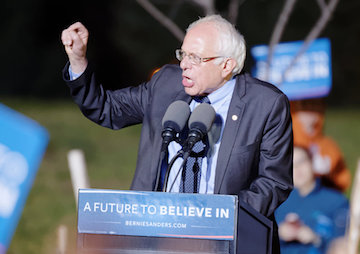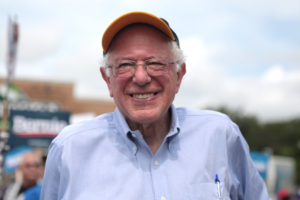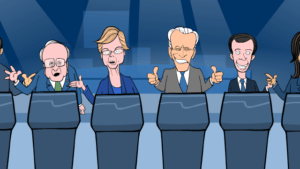How the Age of Acquiescence Came to an End
The larger-than-life presence of Bernie Sanders and Donald Trump on the national stage may be the most improbable political development of the last half-century. It suggests that we are entering a new phase in our public life. Bernie Sanders speaks at a campaign rally in the South Bronx. (Michael Vadon / CC-BY-2.0)
1
2
3
Bernie Sanders speaks at a campaign rally in the South Bronx. (Michael Vadon / CC-BY-2.0)
1
2
3

Bernie Sanders speaks at a campaign rally in the South Bronx. (Michael Vadon / CC-BY-2.0)
Arising from the shadows of the American repressed, Bernie Sanders and Donald Trump have been sending chills through the corridors of establishment power. Who would have thunk it? Two men, both outliers, though in starkly different ways, seem to be leading rebellions against the masters of our fate in both parties; this, after decades in which even imagining such a possibility would have been seen as naïve at best, delusional at worst. Their larger-than-life presence on the national stage may be the most improbable political development of the last American half-century. It suggests that we are entering a new phase in our public life.
A year ago, in my book The Age of Acquiescence, I attempted to resolve a mystery hinted at in its subtitle: “The rise and fall of American resistance to organized wealth and power.” Simply stated, that mystery was: Why do people rebel at certain moments and acquiesce in others?
Resisting all the hurts, insults, threats to material well-being, exclusions, degradations, systematic inequalities, over-lordship, indignities, and powerlessness that are the essence of everyday life for millions would seem natural enough, even inescapable, if not inevitable. Why put up with all that?
Historically speaking, however, the impulse to give in has proven no less natural. After all, to resist is often to risk yourself, your means of livelihood, and your way of life. To rise up means to silence those intimidating internal voices warning that the overlords have the right to rule by virtue of their wisdom, wealth, and everything that immemorial custom decrees. Fear naturally closes in.
In our context, then, why at certain historical moments have Americans shown a striking ability to rise up, at other times to submit?
To answer that question, I explored those years in the first gilded age of the nineteenth century when millions of Americans took to the streets to protest, often in the face of the armed might of the state, and the period in the latter part of the twentieth century and the first years of this one when the label “the age of acquiescence” seemed eminently reasonable — until, in 2016, it suddenly didn’t.
So consider this essay a postscript to that work, my perhaps belated realization that the age of acquiescence has indeed come to an end. Millions are now, of course, feeling the Bern and cheering The Donald. Maybe I should have paid more attention to the first signs of what was to come as I was finishing my book: the Tea Party on the right, and on the left Occupy Wall Street, strikes by low-wage workers, minimum and living wage movements, electoral victories for urban progressives, a surge of environmental activism, and the eruption of the Black Lives Matter movement just on the eve of publication.
But when you live for so long in the shade of acquiescence where hope goes to die or at least grows sickly, you miss such things. After all, if history has a logic, it can remain so deeply hidden as to be indecipherable… until it bites. So, for example, if someone had X-rayed American society in 1932, in the depth of the Great Depression, that image would have revealed a body politic overrun with despair, cynicism, fatalism, and fear — in a word, acquiescence, a mood that had shadowed the land since “black Tuesday” and the collapse of the stock market in 1929.
Yet that same X-ray taken in 1934, just two years later, would have revealed a firestorm of mass strikes, general strikes, sit-down strikes, rent strikes, seizures of shuttered coal mines and utilities by people who were cold and lightless, marches of the unemployed, and a general urge to unseat the ancien régime; in a word, rebellion. In this way, the equilibrium of a society can shift phases in the blink of an eye and without apparent warning (although in hindsight historians and others will explore all the reasons everybody should have seen it coming).
Liberalism vs. Liberalism
Anticipated or not, a new age of rebellion has begun, one that threatens the status quo from the left and the right. Perhaps its most shocking aspect: people are up in arms against liberalism.
That makes no sense, right? How can it, when come November the queen of liberalism will face off against the billionaire standard bearer of Republicanism? In the end, the same old same old, yes? Liberal vs. conservative.
Well, not really. If you think of Hillary as the “limousine liberal” of this election season and The Donald as the right-wing “populist in pinstripes,” and consider how each of them shimmied their way to the top of the heap and who they had to fend off to get there, a different picture emerges. Clinton inherits the mantle of a liberalism that has hollowed out the American economy and metastasized the national security state. It has confined the remnants of any genuine egalitarianism to the attic of the Democratic Party so as to protect the vested interests of the oligarchy that runs things. That elite has no quarrel with racial and gender equality as long as they don’t damage the bottom line, which is after all the defining characteristic of the limousine liberalism Hillary champions. Trump channels the hostility generated by that neoliberal indifference to the well-being of working people and its scarcely concealed cultural contempt for heartland America into a racially inflected anti-establishmentarianism. Meanwhile, Bernie Sanders targets Clintonian liberalism from the other shore. Liberalism is, in other words, besieged.
The Sixties Take on Liberalism
How odd! For decades “progressives” have found themselves defending the achievements of liberal reform from the pitiless assault of an ascendant conservatism. It’s hard to remember that the liberal vs. conservative equation didn’t always apply (and so may not again).
Go back half a century to the 1960s, however, and the battlefield seems not dissimilar to today’s terrain. That was a period when the Vietnam antiwar movement indicted liberalism for its imperialism in the name of democracy, while the civil rights and black power movements called it out for its political alliance with segregationists in the South.
In those years, the New Left set up outposts in urban badlands where liberalism’s boast about the U.S. being an “affluent society” seemed like a cruel joke. Students occupied campus buildings to say no to the bureaucratization of higher education and the university’s servitude to another liberal offspring, the military-industrial complex. Women severed the knot tying the liberal ideal of the nuclear family to its gendered hierarchy. The counterculture exhibited its contempt for liberalism’s sense of propriety in a thousand ways. No hairstyle conventions, marriage contracts, sexual inhibitions, career ambitions, religious orthodoxies, clothing protocols, racial taboos, or chemical prohibitions escaped unscathed.
Your support matters…Independent journalism is under threat and overshadowed by heavily funded mainstream media.
You can help level the playing field. Become a member.
Your tax-deductible contribution keeps us digging beneath the headlines to give you thought-provoking, investigative reporting and analysis that unearths what's really happening- without compromise.
Give today to support our courageous, independent journalists.






You need to be a supporter to comment.
There are currently no responses to this article.
Be the first to respond.